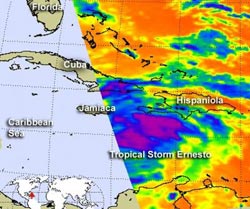NASA sees a strengthening Tropical Storm Ernesto

NASA's Aqua satellite passed over Tropical Storm Ernesto on Aug. 5 at 1753 UTC (1:53 p.m. EDT). The AIRS instrument captured an infrared image of the eastern half of the storm where cloud temperatures exceeded -63 Fahrenheit (-52 Celsius) indicating strong thunderstorms with heavy rainfall (purple).<br><br>Credit: NASA JPL, Ed Olsen<br>
NASA infrared data revealed strong thunderstorms on August 5 that indicated a strengthening storm, and the GOES-13 satellite showed a well-organized tropical storm 24 hours later.
NOAA's Hurricane hunter aircraft investigated Tropical Storm Ernesto on the morning of August 6 and found deep convection (rising air that forms the thunderstorms that make up a tropical cyclone) and that the center was actually located northeast of where previously thought.
NASA's Aqua satellite passed over Tropical Storm Ernesto on August 5 at 1753 UTC (1:53 p.m. EDT) when the storm's maximum sustained winds were near 50 mph (85 kmh). The Atmospheric Infrared Sounder (AIRS) instrument captured an infrared image of the eastern half of the storm where cloud temperatures exceeded -63 Fahrenheit (-52 Celsius) indicating strong thunderstorms with heavy rainfall. Ernesto continued to strengthen after Aqua passed by.
NOAA's GOES-13 satellite has been continuously providing imagery of Ernesto. A visible image of Tropical Storm Ernesto from GOES-13 on August 6 at 11:45 a.m. EDT showed an organized, rounded storm with strong convection (rising air that forms the thunderstorms that make up a tropical cyclone).
At 11 a.m. EDT (1500 UTC) Tropical Storm Ernesto's maximum sustained winds were near 65 mph (100 kmh). The National Hurricane Center (NHC) expects Ernesto to strengthen into a hurricane later in the day. The center was only 190 miles (205 km) east-northeast of Cabo Gracias A Dios on the Nicaragua/Honduras border, near latitude 15.8 north and longitude 80.5 west. Ernesto is moving toward the west-northwest near 9 mph (15 kmh) and that general motion is expected to continue for the next two days. Because Ernesto has continued moving west, the Cayman Islands discontinued their tropical storm watch for Grand Cayman. The NHC noted that “Ernesto's center will be passing north of the coast of Honduras tonight and Tuesday and approach the east coast of the Yucatan peninsula early Wednesday.”
The NHC summarized the watches and warnings in effect today, August 6, 2012: The government of Mexico has issued a hurricane warning for the east coast of the Yucatan peninsula from Chetumal northward to Punta Allen and has issued a tropical storm warning from north of Punta Allen to Tulum. The government of Mexico has also issued a Tropical Storm Watch from north of Tulum to Chetumal. In Belize, there's a hurricane watch for the entire coast.
Ernesto is expected to strengthen to hurricane status by the end of the day on Monday, August 6.
Media Contact
More Information:
http://www.nasa.govAll latest news from the category: Earth Sciences
Earth Sciences (also referred to as Geosciences), which deals with basic issues surrounding our planet, plays a vital role in the area of energy and raw materials supply.
Earth Sciences comprises subjects such as geology, geography, geological informatics, paleontology, mineralogy, petrography, crystallography, geophysics, geodesy, glaciology, cartography, photogrammetry, meteorology and seismology, early-warning systems, earthquake research and polar research.
Newest articles

Combining robotics and ChatGPT
TUM professor uses ChatGPT for choreographies with flying robots. Prof. Angela Schoellig has proved that large language models can be used safely in robotics. ChatGPT develops choreographies for up to…

How the Immune System Learns from Harmless Particles
Our lungs are bombarded by all manner of different particles every single day. Whilst some are perfectly safe for us, others—known as pathogens—have the potential to make us ill. The…

Biomarkers identified for successful treatment of bone marrow tumours
CAR T cell therapy has proven effective in treating various haematological cancers. However, not all patients respond equally well to treatment. In a recent clinical study, researchers from the University…





















